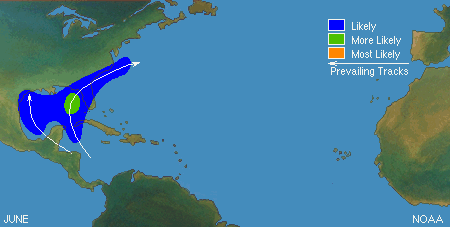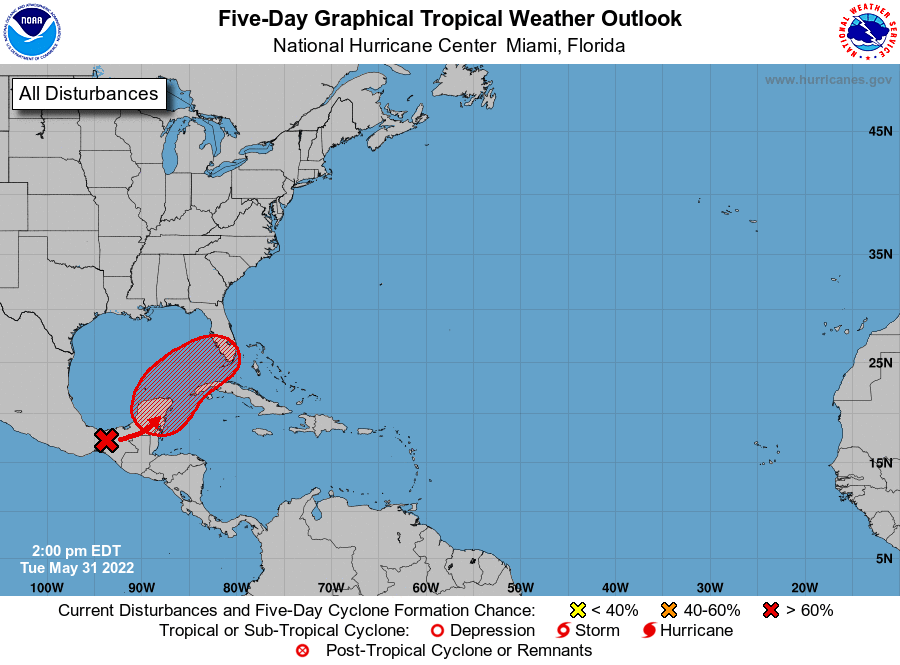For the first time since 2014, we made it to the official start of Hurricane Season without having a named storm already develop.

2021 featured another very active season, with a total of 21 named storms (we’re still skeptical on at least a few of them), making it the 3rd most active storm on record. Only one storm, Ida, had its name retired. Ida slammed into Louisiana as a Category 4 storm, inflicting more than $60 Billion in damage and resulting in 55 deaths. Here in New England, we had 2 tropical storms make landfall last season. Both Elsa and Henri each made landfall near Westerly, Rhode Island about 6 weeks apart. This is just the 5th time since 1851 that two tropical systems made landfall in Southern New England or Long Island in the same year, and only the 2nd time (1961 being the other), that both storms were only tropical storm strength. (We’ll have more info on New England tropical systems a little later in this post)

It looks like another active season is expected this year. NOAA issued their seasonal hurricane outlook on May 24, and it calls for a 65 percent chance for an above normal season, a 25 percent chance for a normal season, and a 10 percent chance for a below normal season. Many of the other hurricane outlooks issued by various outlets are also expecting a busy season, due to a number of factors. An average season consists of 14.4 named storms, of which 7.2 become hurricanes and 3.2 become major hurricanes (Category 3 or higher on the Saffir-Simpson scale). NOAA’s forecast for this season calls for 13-20 named storms, 6-10 hurricanes, and 3-5 major hurricanes. The Tropical Meteorology Project at Colorado State, the first group to forecast how active a hurricane season would be, originally led by Dr. Bill Gray, will issue their updated forecast on June 2. Their initial forecast from April called for 19 named storms, 9 hurricanes, and 4 major hurricanes. They also pegged the chance at a storm making landfall in the United States at 71% (52% is the average in any given year), and the odds of a storm making landfall along the East Coast at 47% (31% is the average). The last 7 seasons have all featured above normal activity across the Atlantic.

Despite the early start for the past several years, the average date for the first named storm in the Atlantic is still June 20, and the average date for the first hurricane is August 11. Over 97% of all named storms in the Atlantic form between June 1 and November 30. Most early season storms tend to be on the weaker side. A hurricane hasn’t made landfall in the United States before July 1 since Hurricane Bonnie came ashore as a minimal hurricane near the Texas/Louisiana border on June 26, 1986.

A busy season does not always mean that multiple storms (or any storms for that matter) will impact the United States, though 2020 saw much of the Gulf Coast and East Coast threatened by tropical systems. In 2010, 19 named storms were observed in the Atlantic, 12 of them became hurricanes, and 5 were major hurricanes. Only one storm made landfall in the United States, and that was Bonnie, which was a minimal tropical storm at landfall. In 1990, there were a total 14 named storms, 8 of them hurricanes and 1 major hurricane. Not a single one of them made landfall in the United States. On the flip side, an inactive year doesn’t mean much for landfall probabilities as well. Only 7 named storms formed in 1992, and the 1st one didn’t develop until August 16. That storm, however, was named Andrew, and it made landfall just south of Miami as a category 5 storm. It only takes one storm to ruin your entire year.
Here in New England, we should always pay attention when a storm is nearing the Bahamas, as those are the ones that have the potential to impact us, and we are very overdue for a hurricane to head this way. Using data back to 1851, here are some stats that show how overdue we are:
- Since 1851, 39 storms of tropical storm strength of greater have made landfall in New England or Long Island, an average of one every 4.4 years. The longest we’ve ever gone without one is 11 years, between 1897 and 1908 and also between 1923 and 1934. Last year, we had two tropical storms (Elsa and Henri) make landfall in the region.
- Since 1851, 32 strong tropical storms (maximum sustained winds of 60 mph or more) have made landfall in New England or Long Island, an average of one every 5.3 years. The longest we’ve ever gone without one is 19 years, between 1897 and 1916. Last year, we had two strong tropical storms (Elsa and Henri) make landfall in the region.
- Since 1851, a hurricane has made landfall in New England or Long Island 18 times, an average of one every 9.5 years. The longest we’ve ever gone between hurricane landfalls is 38 years, between 1896 and 1934. It’s been 31 years since Bob, our 2nd longest drought on record.
- Since 1851, 8 hurricanes of Category 2 intensity or stronger have made landfall in New England or Long Island, an average of one every 21.4 years. The longest we’ve gone between hits by storms of that intensity is 69 years, between 1869 and 1938. We’re at 31 years since Bob, the last one to do so.
- Since 1851, New England/Long Island has had 3 Major Hurricanes (Category 3 or higher) make landfall – an unnamed storm in October of 1869, the infamous 1938 Long Island Express, and Hurricane Carol in 1954. That’s an average of 1 every 57 years, and the longest time between 2 major hurricanes is 69 years (1869-1938). We’re at 67 years since Carol. There are also 3 documented storms from before 1851 – The Great Colonial Hurricane of 1635, the 1815 New England Hurricane, and the Norfolk and Long Island Hurricane of 1821. That’s it. That changes the numbers to 6 in 387 years, or one every 64.5 years, with a longest drought of 180 years.

We all saw what Sandy did in 2012, and that was a minimal hurricane that eventually made landfall in southern New Jersey (technically as an extratropical storm). When (not if) the next big storm comes up the coast, much of this region will not be prepared for the storm or its aftermath.
The Atlantic is quiet right now (more on that in a moment), but even if something were to form off the East Coast in the next few weeks and head this way, the waters off of New England are much too cold to sustain a tropical system, so we’d see something more like a typical nor’easter. Only two tropical storms have ever made landfall in the Northeast before the end of June. The first was an unnamed minimal tropical storm that crossed extreme eastern Long Island and went into southeastern Connecticut on May 30, 1908. The other was Tropical Storm Agnes, which made landfall near New York City on June 22, 1972, then caused devastating flooding across parts of the Mid-Atlantic states. In terms of hurricanes, the earliest one to ever make landfall up this way was Hurricane Belle, which slammed into Long Island with 90 mph winds on August 9, 1976. We did have Hurricane Arthur pass just offshore of Nantucket on July 4, 2014. While it did not make landfall, it made for a rather wet and cool holiday, especially across Cape Cod and southeastern Massachusetts. Statistically, the most likely time for a hurricane to hit New England is between the middle of August and late September. Of the 18 hurricanes that made landfall in New England or Long Island since 1851, 15 of them have done so between August 19 and September 27.

As always, you should get your weather information from a trusted source, especially when dealing with tropical systems. Much like with snowstorms in the winter, there will be plenty of hype and exaggeration on Twitter and Facebook, as well as people posting doom and gloom maps showing how a thunderstorm near the coast of Africa will develop into a Category 5 storm and head right for the East Coast in the next 2 weeks. We’re not among that group, we give you facts and our best forecasts, without any hype. If there’s reason to worry, we’ll let you know with plenty of advance warning. It’s always best to prepare ahead of the season. Chances are, you won’t have anything to worry about, but in case you do, it’s always good to be prepared, as we’ve learned recently.

There is something we’re keeping an eye on as hurricane season begins. Hurricane Agatha made landfall on the Pacific side of Mexico yesterday. It will dissipate today or tomorrow, but what’s left of it will drift towards the Yucatan Peninsula and then likely the southeastern Gulf of Mexico As it does so, conditions could be favorable for it to become a new tropical depression toward the end of the week. Whether it does or doesn’t develop, it will bring some heavy rain to parts of Florida, Cuba, and the Bahamas this weekend.